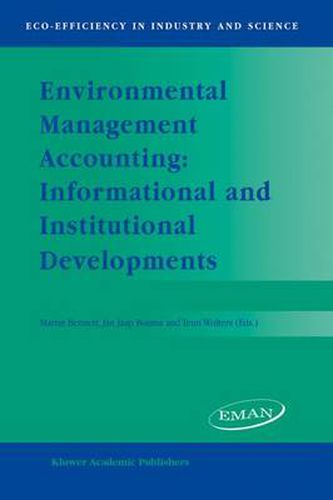Readings Newsletter
Become a Readings Member to make your shopping experience even easier.
Sign in or sign up for free!
You’re not far away from qualifying for FREE standard shipping within Australia
You’ve qualified for FREE standard shipping within Australia
The cart is loading…






This title is printed to order. This book may have been self-published. If so, we cannot guarantee the quality of the content. In the main most books will have gone through the editing process however some may not. We therefore suggest that you be aware of this before ordering this book. If in doubt check either the author or publisher’s details as we are unable to accept any returns unless they are faulty. Please contact us if you have any questions.
This volume aims to aid the integration of a company’s environmental and business interests, thereby enhancing corporate eco-efficiency in terms of reducing environmental costs or making one’s product more competitive. It presents a number of EMA frameworks that companies can take as a basis for implementing their own specific EMA structures. Besides discussing environmental accounting issues within conventional management accounting, it gives a detailed picture of materials flow (cost) accounting as an alternative way of looking at the ecology-economy relationships at the corporate level. A case study shows how a large company (Siemens) applies materials flow accounting and what benefits it entails. Applying EMA in an effective way may require the use of information systems. The book discusses the pros and cons of different strategies in this area; one may opt for a total integrated solution, partially integrated solutions or for a stand-alone system. Governments may have good reasons to promote the application of EMA. The use of economic instruments to internalise environmental externalities (norms, ecotaxes and tradable permits) can be much more effective if the incentives they produce are not frustrated by a lack of adequate cost accounting. EMA can be of great importance here. The book discusses a number of these issues, giving information on how international and national organisations (such as in Japan) have taken steps to promote the adoption of EMA by the business community. A final section presents a number of different topics such as how environmental costs can be of help in defining environmental management strategies, and how to take environmental performance indicators a step further by developing sustainability indicators for product chains. A final chapter explores a possible theoretical foundation for research on why, how and to what extent companies adopt EMA. Such research may help to turn available insights as to what EMA should be into effective EMA strategies.
$9.00 standard shipping within Australia
FREE standard shipping within Australia for orders over $100.00
Express & International shipping calculated at checkout
Stock availability can be subject to change without notice. We recommend calling the shop or contacting our online team to check availability of low stock items. Please see our Shopping Online page for more details.
This title is printed to order. This book may have been self-published. If so, we cannot guarantee the quality of the content. In the main most books will have gone through the editing process however some may not. We therefore suggest that you be aware of this before ordering this book. If in doubt check either the author or publisher’s details as we are unable to accept any returns unless they are faulty. Please contact us if you have any questions.
This volume aims to aid the integration of a company’s environmental and business interests, thereby enhancing corporate eco-efficiency in terms of reducing environmental costs or making one’s product more competitive. It presents a number of EMA frameworks that companies can take as a basis for implementing their own specific EMA structures. Besides discussing environmental accounting issues within conventional management accounting, it gives a detailed picture of materials flow (cost) accounting as an alternative way of looking at the ecology-economy relationships at the corporate level. A case study shows how a large company (Siemens) applies materials flow accounting and what benefits it entails. Applying EMA in an effective way may require the use of information systems. The book discusses the pros and cons of different strategies in this area; one may opt for a total integrated solution, partially integrated solutions or for a stand-alone system. Governments may have good reasons to promote the application of EMA. The use of economic instruments to internalise environmental externalities (norms, ecotaxes and tradable permits) can be much more effective if the incentives they produce are not frustrated by a lack of adequate cost accounting. EMA can be of great importance here. The book discusses a number of these issues, giving information on how international and national organisations (such as in Japan) have taken steps to promote the adoption of EMA by the business community. A final section presents a number of different topics such as how environmental costs can be of help in defining environmental management strategies, and how to take environmental performance indicators a step further by developing sustainability indicators for product chains. A final chapter explores a possible theoretical foundation for research on why, how and to what extent companies adopt EMA. Such research may help to turn available insights as to what EMA should be into effective EMA strategies.